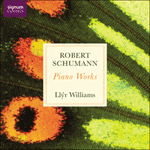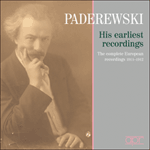
Welcome to Hyperion Records, a British classical label devoted to presenting high-quality recordings of music of all styles and from all periods from the twelfth century to the twenty-first.
Hyperion offers both CDs, and downloads in a number of formats. The site is also available in several languages.
Please use the dropdown buttons to set your preferred options, or use the checkbox to accept the defaults.

| Llŷr Williams (piano)» More |



I wrote to you about a premonition. I had it in the days from 24th to 27th March, during my new composition. There is a passage which keeps coming back, to which I kept returning. It is as though someone were sighing with a heavy heart: ‘Oh God!’ While composing, I kept seeing funeral processions, coffins, unhappy, despairing people, and when I had finished and had long sought a title I kept coming to Leichenphantasie [corpse-fantasy]. Isn’t that curious? While I was composing I was often so overcome that tears came forth and I really didn’t know why and had no reason for them. Then Therese’s letter arrived, and it stood clearly before me.
Therese was Schumann’s sister-in-law. Her letter informed him that his brother Eduard was seriously ill. Convinced that he would never see Eduard again, Schumann hurried away from Vienna. On the way home, he distinctly heard in his mind the sound of a funeral chorale played by trombones. As he later found out, that was the precise moment when his brother had died.
Schumann eventually called his new pieces Nachtstücke, borrowing his title, not for the first time, from ETA Hoffmann. He originally gave a separate heading to each of the four pieces in the cycle, though these were suppressed in the first edition: ‘Trauerzug’ (Funeral procession), ‘Kuriose Gesellschaft’ (Strange company), ‘Nächtliche Gelage’ (Nocturnal revelries) and ‘Rundgesang mit Solostimmen’ (Round with solo voices).
The funeral procession of Schumann’s opening piece is one that advances with hesitant steps. The cortège seems, moreover, to have started out of earshot, with the music beginning as though midstream. During the course of the piece it draws gradually nearer, until shortly before the close it is heard fortissimo, in chords whose widely spaced keyboard layout anticipates the texture of the final piece in Schumann’s collection. At the end, the procession recedes once more into the distance—so much so that we cannot be quite sure of having caught the sound of the delayed final chord.
The main subject of the second piece seems to bring with it the sound of laughter in the chortling accents of the main theme. The entire number is based on the descending scale pattern of this theme, which itself is like an accelerated parody of the funeral procession we have just heard. During the course of the piece Schumann manages to transform the motif into an elegant, lyrical interlude, into a recitative and—in inverted form—into a chuckling intermezzo, before the whole thing is finally brushed aside with a dismissive gesture.
The penultimate piece, with its first episode in an agitated minor key, seems to rush past us like the wind; and having begun in a tempo of great liveliness, the music’s pace increases for a second episode whose sweeping gestures soon give way to two-note phrases which cut across the triple-time beat, introducing an atmosphere of still greater breathlessness.
If the title Schumann at one stage thought of giving the first of his Nachtstücke had distinctly Mahlerian undertones, then the final piece in the collection is one that Mahler may actually have known. Its opening bars are strikingly similar to the refrain which punctuates the second of the two ‘Nachtmusik’ movements in the later composer’s Seventh Symphony. The inspired melody that follows begins with a yearning ascending interval in a rhythm that later forms the springboard for a sensuous middle section; until, with great subtlety, the closing notes of that middle section overlap with the return of the sighing initial phrase of the piece. In the final bars, as the gentle pizzicato of the opening theme becomes progressively smoother, the poet speaks, allowing the music to sink to a subdued close at the bottom of the keyboard.
from notes by Misha Donat © 2014
Je t’ai écrit à propos d’un pressentiment; je l’ai eu du 24 au 27 mars, pendant ma nouvelle composition. Il y a un passage qui revient tout le temps, auquel je retourne sans cesse; c’est comme si quelqu’un soupirait, le cœur lourd: «ah! mon Dieu»—pendant que je composais, je voyais toujours des cortèges funèbres, des cercueils, des gens malheureux, désespérés, et une fois que j’eus terminé, et longtemps cherché un titre, je revenais toujours à Leichenphantasie [Fantaisie des cadavres]—n’est-ce pas étrange? Pendant la composition, aussi, j’ai souvent été si ému que les larmes me sont venues, sans que je sache pourquoi, ni que j’aie une quelconque raison—puis la lettre de Therese est arrivée, et tout s’est éclairé.
Therese était la belle-sœur de Schumann. Sa lettre lui apprenait que son frère Eduard était gravement malade. Convaincu qu’il ne le reverrait jamais, Schumann quitta précipitamment Vienne. En chemin, il entendit distinctement dans sa tête un choral funèbre joué par des trombones. Plus tard, il découvrit que son frère était mort à cet instant précis.
Finalement, Schumann intitula ses nouvelles pièces Nachtstücke, un titre emprunté—et ce n’était pas la première fois—à E. T. A. Hoffmann. Au départ, chacune des quatre œuvres de ce cycle reçut un titre—«Trauerzug» (Cortège funèbre), «Kuriose Gesellschaft» (Étrange compagnie), «Nächtliche Gelage» (Banquet nocturne) et «Rundgesang mit Solostimmen» (Ronde avec voix solistes)—, mais tous furent supprimés dans la première édition.
Le cortège funèbre de la pièce inaugurale avance à pas hésitants. Qui plus est, il semble s’être élancé hors de portée de voix, la musique démarrant comme au beau milieu pour se faire de plus en plus proche au fil de l’œuvre, jusqu’à ce que, peu avant la conclusion, on l’entende fortissimo, en des accords dont l’agencement claviéristique très espacé anticipe la texture de la dernière pièce du recueil. À la fin, le cortège repart dans le lointain—au point que nous ne pouvons être totalement sûrs d’avoir saisi le son de l’accord terminal retardé.
Les premières mesures de la deuxième pièce semblent drainer des rires dans son sillage, dans les accords gloussants du thème principal. Tout le morceau repose sur le motif en gamme descendante de ce thème, lequel s’apparente à une parodie accélérée du cortège funèbre que l’on vient d’entendre. Au gré de l’œuvre, Schumann parvient à transformer le motif en un élégant interlude lyrique, en un récitatif et—sous une forme renversée—en un intermezzo gloussant, avant que le tout soit finalement balayé d’un geste dédaigneux.
L’avant-dernière pièce, avec son premier épisode rédigé dans une tonalité mineure agitée, semble filer devant nous comme le vent; et après avoir démarré dans un tempo d’une grande allégresse, le rythme s’accélère pour un second épisode, dont les gestes amples cèdent bientôt la place à des phrases de deux notes allant à l’encontre de la battue à trois temps pour un climat encore plus haletant.
Si, à un moment, Schumann envisagea de donner au premier de ses Nachtstücke un titre à l’écho nettement mahlérien, la dernière pièce de ce recueil est un morceau que Mahler a bel et bien pu connaître. Ses mesures inaugurales sont étonnamment similaires au refrain qui ponctue le dernier des deux mouvements «Nachtmusik» de la Symphonie nº 7 de Mahler. La mélodie inspirée qui suit s’ouvre sur un langoureux intervalle ascendant, dans un rythme qui servira de tremplin à une sensuelle section centrale, dont les notes conclusives se chevauchent très subtilement avec le retour de la première phrase soupirante de l’œuvre. Dans les dernières mesures, alors que le doux pizzicato du thème d’ouverture se fait plus régulier, c’est le poète qui parle, permettant à la musique de sombrer en une conclusion contenue, au fond du clavier.
extrait des notes rédigées par Misha Donat © 2014
Français: Hypérion
Von einer Ahnung schrieb ich Dir; ich hatte sie in den Tagen vom 24sten bis 27sten März bei meiner neuen Composition; es kommt darin immer eine Stelle vor, auf die ich immer zurückkam; die ist, als seufzte Jemand recht aus schwerem Herzen „ach Gott“—ich sah bei der Composition immer Leichenzüge, Särge, unglückliche verzweifelte Menschen, und als ich fertig war und lang nach einem Titel suchte, kam ich immer auf den: Leichenphantasie—Ist das nicht merkwürdig?—Beim Componieren war ich auch oft so ergriffen, daß mir die Thränen hervorkamen und wußte doch nicht warum und hatte keinen Grund dazu—da kam Theresens Brief und nun stand es klar vor mir.
Therese war Schumanns Schwägerin. In ihrem Brief informierte sie ihn über die schwere Erkrankung seines Bruders. Überzeugt, dass er Eduard nicht mehr wiedersehen würde, verließ Schumann eilig Wien. Während der Rückreise vernahm er deutlich den Klang eines von Posaunen gespielten Trauerchorals. Später fand er heraus, dass dies genau der Zeitpunkt war, an dem sein Bruder gestorben war.
Schumann gab den neuen Werken schließlich den Titel Nachtstücke nach E. T. A. Hoffmann, von dem er nicht zum ersten Mal einen Titel entlehnt hatte. Ursprünglich hatte jedes der vier Stücke des Zyklus eine eigene Überschrift: „Trauerzug“, „Kuriose Gesellschaft“, „Nächtliche Gelage“ und „Rundgesang mit Solostimmen“; diese wurden allerdings in der Erstausgabe fortgelassen.
Der Trauerzug von Schumanns erstem Stück schreitet zögernd voran. Die Prozession scheint überdies außer Hörweite begonnen zu haben, denn die Musik setzt gleichsam mittendrin ein. Im Verlauf des Stückes kommt sie allmählich näher, bis kurz vor dem Schluß Akkorde im fortissimo erklingen, deren weiträumige Anordnung auf den Klaviertasten die Textur im letzten Stück von Schumanns Zyklus vorwegnimmt. Am Ende verschwindet die Prozession wieder in der Ferne—und zwar so, dass man nicht ganz sicher ist, den verzögerten Schlußakkord vernommen zu haben.
Das zweite Stück scheint den Klang von Gelächter in den glucksenden Akzenten des Hauptthemas auszulösen. Das ganze Stück beruht auf den Skalen dieses Themas, das wie eine beschleunigte Parodie des gerade gehörten Trauerzuges anmutet. Im Verlauf des Stückes wandelt Schumann das Motiv in ein elegantes, lyrisches Zwischenspiel, ein Rezitativ und—in umgekehrter Form—ein kicherndes Intermezzo um, bis das Ganze beiläufig hinweggefegt wird.
Das vorletzte Stück scheint in einer ersten erregten Moll-Episode wie der Wind an uns vorbeizufegen; und nach einem sehr lebhaften Beginn wird die Musik in einer zweiten Episode noch schneller; ihr Schwung weicht bald Phrasen aus zwei Tönen, die den Dreiertakt durchkreuzen und so die Atemlosigkeit noch verstärken.
Klingt der Titel, den Schumann zunächst dem ersten der Nachtstücke geben wollte, schon deutlich an Mahler an, so könnte Mahler das letzte Stück des Zyklus tatsächlich gekannt haben. Die Anfangstakte gleichen auffallend dem Refrain im zweiten der beiden „Nachtmusik“-Sätze der Siebten Sinfonie des jüngeren Komponisten. Die folgende inspirierte Melodie beginnt mit einem sehnsüchtigen aufsteigenden Intervall in einem Rhythmus, der später als Ausgangspunkt für einen reizvollen Mittelteil dient, bis sich die letzten Töne jenes Mittelteils sehr subtil mit der Wiederkehr der Seufzerphrase vom Anfang des Stückes überschneiden. Wenn in den letzten Takten das zarte Pizzikato des Anfangsthemas immer weicher wird, spricht der Dichter, während die Musik zu einem gedämpften Schluß in den tiefen Tasten absinkt.
aus dem Begleittext von Misha Donat © 2014
Deutsch: Christiane Frobenius
 Piano Works, Vol. 1 Piano Works, Vol. 1Llŷr Williams’ long and successful collaboration with Signum Records continues with this survey of Schumann’s piano works, beginning with the early 'Papillons' completed when he was just twenty.» More |
 Paderewski - His earliest recordings Paderewski - His earliest recordings |

